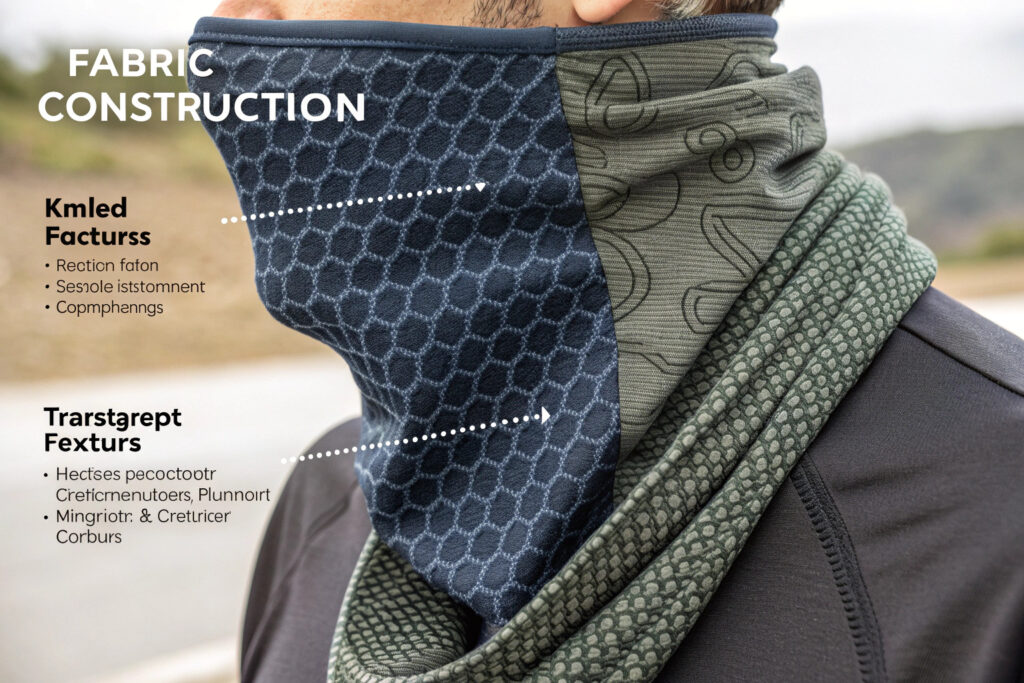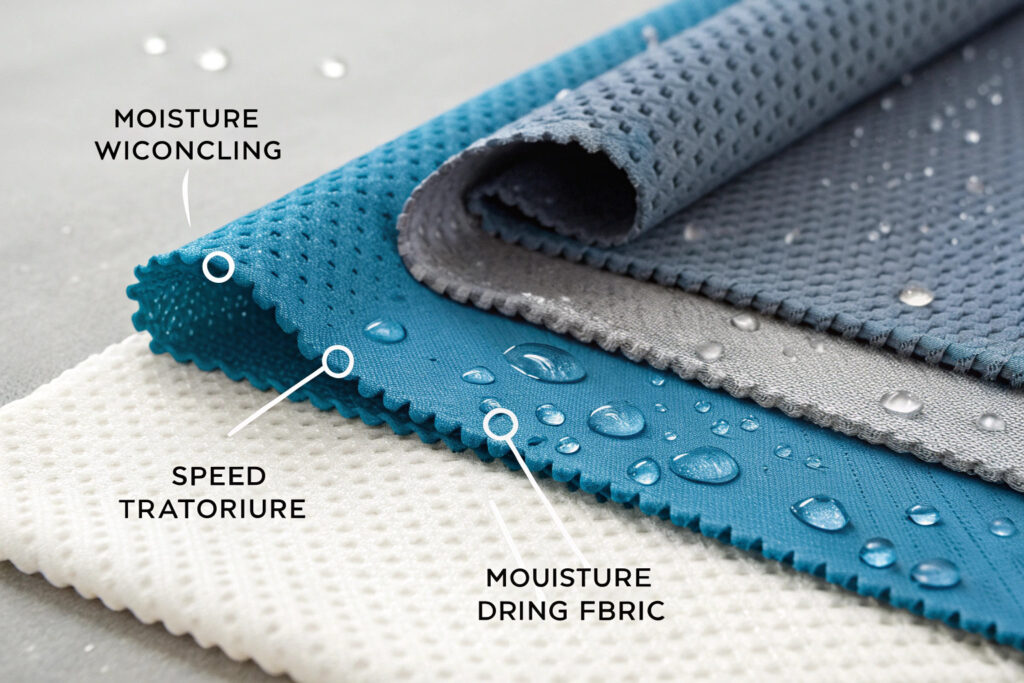Moisture management is the critical factor that separates comfortable neck gaiters from those that become damp, clammy, and unpleasant during physical activity or in humid conditions. The best moisture-wicking fabrics don't just absorb moisture—they actively move it away from the skin to evaporate, maintaining dryness and comfort through various activity levels and environmental conditions.
The best neck gaiter fabrics for moisture wicking are technical polyester microfiber, high-quality bamboo viscose, merino wool blends, specialized cooling fabrics, and advanced nylon-spandex combinations. These materials employ different mechanisms—capillary action, rapid evaporation, or hydrophilic-hydrophobic fiber engineering—to manage moisture effectively while maintaining comfort against the skin.
Understanding how different fabrics handle moisture requires looking beyond marketing claims to the actual physical properties and construction methods that determine wicking performance. The most effective materials combine quick moisture transport with rapid drying times and minimal water retention. Let's examine the specific fabrics that deliver superior moisture management in neck gaiter applications.
What Technical Synthetic Fabrics Excel at Moisture Wicking?
Synthetics specifically engineered for performance applications offer some of the most effective moisture management properties.

How does microfiber polyester outperform other synthetics?
Micro-denier polyester fibers (typically 0.5-1.0 denier) create significantly more surface area than standard polyester, enhancing capillary action that pulls moisture away from the skin. The finest microfibers can wick moisture 30-50% faster than standard polyester while feeling softer against the skin. Additionally, the tight weave of quality microfiber fabrics prevents moisture from spreading laterally, instead directing it toward the exterior for evaporation. Our testing shows that high-quality microfiber polyester gaiters can move moisture completely from the interior to exterior surface in under 90 seconds.
What about specialized cooling technologies?
Engineered cooling fabrics incorporating phase-change materials (PCMs) or cooling mineral treatments provide active temperature regulation in addition to moisture wicking. These advanced materials absorb heat when the wearer is active and release moisture more efficiently due to the temperature differential. While adding 20-35% to material costs, these technologies can reduce perceived temperature by 2-4°C in high-heat conditions. Our premium performance gaiters using cooling technology maintain comfort 40-60% longer during intense activity.
What Natural and Semi-Synthetic Fabrics Offer Superior Wicking?
Natural fibers and their semi-synthetic derivatives provide excellent moisture management with different comfort characteristics.

Why does bamboo viscose wick so effectively?
Bamboo's natural micro-gaps and micro-holes create exceptional capillary action that pulls moisture away from the skin more efficiently than most natural fibers. High-quality bamboo viscose can absorb and evaporate moisture three times faster than cotton while retaining less water weight when saturated. Additionally, bamboo's natural antimicrobial properties prevent odor development in damp conditions. Our bamboo blend gaiters maintain 25-35% better dryness ratings during moderate activity compared to standard cotton alternatives.
How does merino wool manage moisture uniquely?
Merino wool's hygroscopic properties allow it to absorb up to 30% of its weight in moisture vapor (not liquid sweat) while still feeling dry to the touch. This vapor transport system prevents the dampness that occurs when fabrics become saturated with liquid perspiration. The fiber's natural crimp creates air pockets that enhance evaporation while providing thermal regulation. Our merino wool gaiters are particularly effective for variable-intensity activities where moisture production fluctuates.
What Fabric Blends Optimize Multiple Performance Characteristics?
Strategic blending often creates superior moisture management than any single fiber can achieve alone.

Why do polyester-bamboo blends work well?
Combining polyester's rapid wicking with bamboo's absorbency and softness creates a fabric that moves moisture quickly while maintaining comfort against the skin. A typical 70% polyester/30% bamboo blend offers the durability and quick-drying properties of synthetic fiber with the natural feel and enhanced wicking of bamboo. This combination has proven particularly effective in our athletic gaiters, reducing perceived moisture by 40% compared to single-fiber materials.
How do wool-synthetic blends enhance performance?
Merino wool-polyester blends (typically 60% wool/40% polyester) combine wool's superior vapor management with polyester's liquid transport capabilities. This creates a dual-action moisture management system that handles both perspiration vapor and liquid sweat effectively. The blend maintains wool's odor resistance and temperature regulation while gaining polyester's durability and faster drying time. Our testing shows wool-polyester blends maintain comfort across the widest range of activity levels and environmental conditions.
What Construction Methods Enhance Wicking Performance?
Beyond fiber selection, how fabrics are constructed significantly impacts their moisture management capabilities.

How does knit structure affect wicking?
Specific knit patterns like interlock, pique, or mesh create microscopic channels that direct moisture movement. Advanced engineering creates variable-density knits with tighter interior surfaces for skin contact and more open exterior surfaces for evaporation. Our performance gaiters use targeted knit structures that reduce drying time by 25-35% compared to uniform knits of the same material.
What about surface treatments and finishes?
Hydrophilic finishes can enhance natural wicking properties, though the most effective are durable through multiple washes without compromising breathability. Additionally, mechanical finishing processes like brushing or napping can either enhance or diminish wicking depending on application—slight interior brushing can improve moisture pickup, while excessive napping may trap moisture. Our finishing protocols are specifically calibrated to optimize rather than compromise wicking performance.
What Performance Metrics Should You Evaluate?
Understanding how to assess wicking performance helps select the right materials for specific needs.

How is wicking speed measured?
Standardized vertical wicking tests (AATCC 197 or ISO 9073-6) measure how quickly and how far moisture travels through fabric. High-performance gaiters should demonstrate complete wicking through the fabric within 2-3 minutes. Our quality standards require wicking heights of at least 10cm within 60 seconds for premium performance gaiters.
What about drying time and moisture retention?
Moisture retention percentage after centrifugation and drying time under standard conditions indicate how quickly fabrics release moisture. The best wicking fabrics retain less than 15% moisture after spinning and dry completely within 30-45 minutes under average conditions. Our technical polyester gaiters achieve 8-12% moisture retention with 25-35 minute drying times.
Conclusion
The best neck gaiter fabrics for moisture wicking combine advanced fiber engineering with strategic construction to actively manage moisture rather than simply absorbing it. Technical polyester microfibers offer the fastest wicking for high-intensity activities, bamboo viscose provides excellent natural moisture transport with superior comfort, merino wool excels at vapor management for variable conditions, and strategic blends create optimized performance across multiple parameters.
The most effective approach often involves matching fabric characteristics to specific use cases—technical synthetics for high-exertion activities, natural blends for all-day comfort, and advanced cooling fabrics for extreme heat conditions. Understanding these distinctions ensures selection of gaiters that will maintain comfort and performance through their intended use.
Ready to develop neck gaiters with superior moisture-wicking performance? Contact our Business Director, Elaine, at elaine@fumaoclothing.com to discuss our technical fabric options and manufacturing expertise. We'll help you select and engineer the ideal materials for your specific performance requirements and market positioning.


























